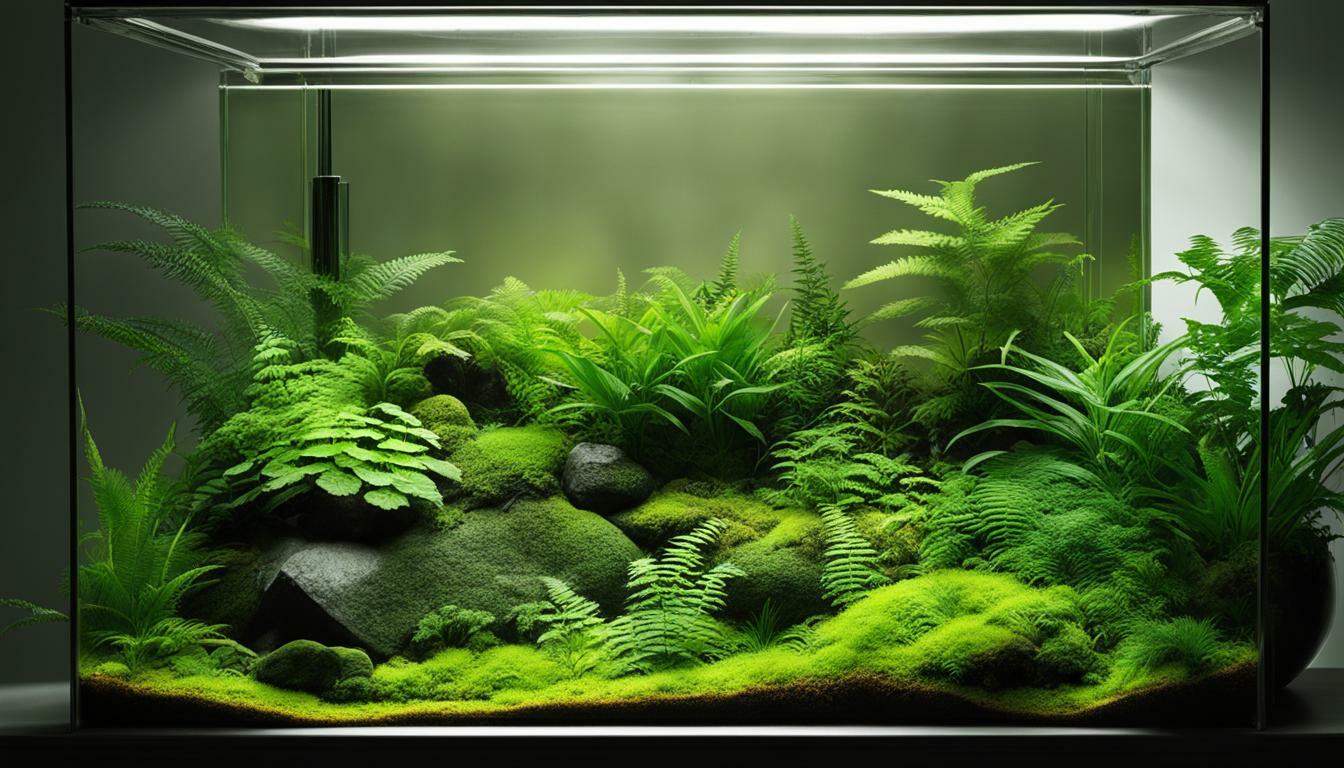Large terrariums are a captivating way to bring the beauty of nature indoors while creating a self-sustaining ecosystem. This detailed guide will provide you with all the information you need to create, maintain, and embellish your very own large terrarium.
When it comes to terrarium plants, the options are endless. The type of terrarium you choose will determine the plants you can include. Closed terrariums are perfect for tropical plant species that thrive in hot and humid environments, while open terrariums suit arid plants that prefer low moisture and humidity levels.
Popular options for terrarium plants include ferns, foliage plants, vines, epiphytes, and moss. It’s essential to select plants that are compatible with the environment you are creating. Smaller varieties and slow-growing plants are recommended for easier maintenance.
To build a large terrarium, you will need a few essential components. These include a suitable glass container, drainage layers to prevent waterlogging, quality soil for plant growth, and hardscape materials like rocks or driftwood for added aesthetics.
Proper care and maintenance are crucial for the longevity of your large terrarium. This includes regular watering to keep the plants hydrated, managing condensation levels to prevent mold or bacterial growth, deadheading and pruning to maintain plant health, and refraining from fertilizing, as terrariums are self-sustaining ecosystems.
Both closed and open terrariums have their advantages and considerations. Closed terrariums require less maintenance but can be prone to bacterial issues if not properly managed. Open terrariums have better air circulation but require more attention to moisture levels.
You can personalize and enhance your large terrarium with various accessories. Consider adding colored pebbles, fairy garden supplies, or different types of glass containers to make it visually appealing and unique to your style.
Terrariums not only serve as home décor but also make great DIY projects. With their aesthetic beauty and endless customization possibilities, large terrariums can add a touch of nature to any space.
Key Takeaways:
- Large terrariums are a great way to bring nature indoors and create a self-sustaining ecosystem.
- Choose the type of terrarium that suits your plant preferences and environment.
- Ferns, foliage plants, vines, epiphytes, and moss are popular choices for terrarium plants.
- Essential components for building a large terrarium include a suitable glass container, drainage layers, soil, and hardscape materials.
- Proper care involves regular watering, managing condensation, and avoiding fertilizing.
With their unique advantages and considerations, closed and open terrariums offer different benefits for plant growth.
Personalize your large terrarium with accessories like colored pebbles, fairy garden supplies, and different glass containers.
Large terrariums are not only beautiful but also make engaging DIY projects and stunning home decor elements.
Creating and maintaining a large terrarium is an easy and rewarding task that can bring nature’s beauty into your home or workspace.
Understanding Different Types of Terrarium Plants
The success of a large terrarium largely depends on selecting the right plants that can thrive in your chosen environment. There are two main types of terrarium plants to consider – closed terrarium plants and open terrarium plants.
Closed terrarium plants are tropical plant species that thrive in the hot and humid conditions of a sealed terrarium. These plants are well-suited for containers that have a tight seal and retain high levels of moisture. Some popular closed terrarium plants include ferns, such as the maidenhair fern and the Boston fern, as well as tropical foliage plants like Fittonia and Peperomia.
On the other hand, open terrarium plants are typically arid species that enjoy low moisture and humidity environments with good airflow. These plants are suitable for containers that have an open or partially open lid, allowing for better air circulation. Examples of open terrarium plants include succulents like Echeveria and Haworthia, as well as cacti such as the Christmas cactus and the zebra cactus.
When choosing terrarium plants, it’s important to consider their growth habit and their compatibility with the size and shape of your terrarium container. Miniature varieties and slower-growing plants are often recommended for easier maintenance. Additionally, it’s essential to select plants that have similar light and water requirements to ensure they thrive in harmony within the terrarium ecosystem.
Table: Terrarium Plant Recommendations
| Plant Type | Closed Terrarium Plants | Open Terrarium Plants |
|---|---|---|
| Common Names | Maidenhair Fern, Boston Fern, Fittonia, Peperomia | Echeveria, Haworthia, Christmas Cactus, Zebra Cactus |
| Light Requirements | Medium to bright indirect light | Bright direct light |
| Watering Needs | Moderate to high | Low to moderate |
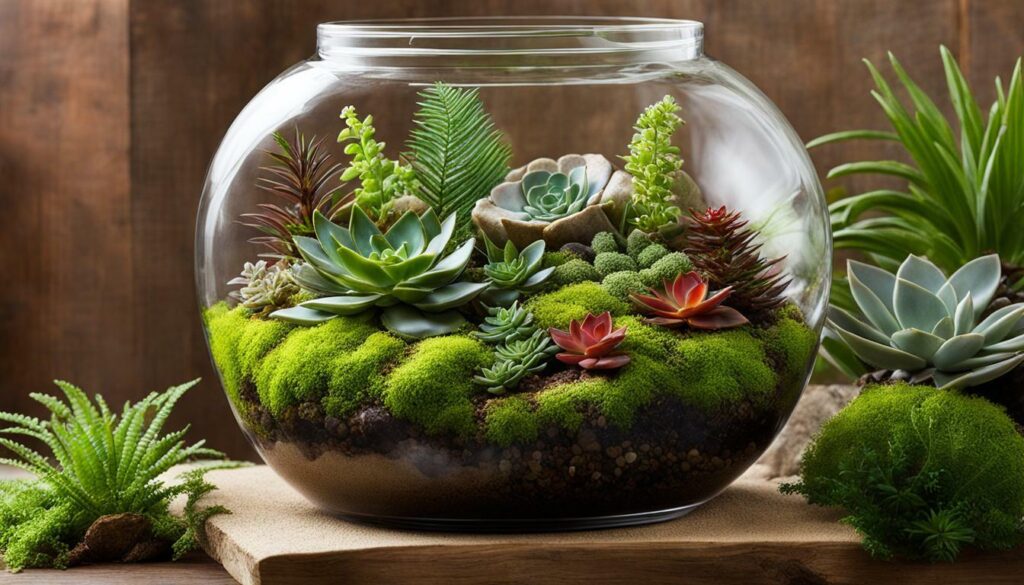
By understanding the different types of terrarium plants and their requirements, you can create a thriving and visually appealing terrarium. Whether you opt for closed terrarium plants that enjoy a humid environment or open terrarium plants that prefer drier conditions, selecting the right plants is key to the success of your terrarium project. Take the time to research and choose plants that not only suit your design aesthetic but also provide the ideal growing conditions within your terrarium.
Selecting the Perfect Plants for Your Large Terrarium
When it comes to selecting plants for your large terrarium, there is a wide range of options to choose from, including beautiful ferns, lush foliage plants, delicate vines, unique epiphytes, and enchanting moss. Each plant brings its own unique charm to the terrarium, creating a miniature ecosystem that is both visually stunning and easy to maintain.
One popular choice for large terrariums is ferns. With their delicate fronds and graceful arching forms, ferns can add a touch of elegance and whimsy to any terrarium. They thrive in the high humidity and low light conditions of a terrarium, making them an excellent choice for creating a lush and verdant environment.
Foliage plants, such as Fittonia or Peperomia, are another fantastic option for large terrariums. Their vibrant leaves, available in a variety of colors and patterns, bring a burst of color and visual interest to the terrarium. These plants are relatively low-maintenance and can tolerate a wide range of lighting conditions, making them versatile and easy to care for.
If you’re looking to add some vertical interest to your terrarium, consider incorporating delicate vines like Pothos or Philodendron. These trailing plants not only create a stunning visual effect as they spill over the sides of the terrarium, but they also help to fill empty spaces and create a sense of depth. Vines are excellent choices for large terrariums as they can quickly grow and fill in the available space.
| Types of Plants for Large Terrariums: |
|---|
| Ferns |
| Foliage Plants |
| Vines |
| Epiphytes |
| Moss |
Epiphytes, such as air plants or bromeliads, are unique plant species that don’t require soil to grow. They can be attached to hardscape materials like rocks or driftwood, adding an interesting and dynamic element to your terrarium. Epiphytes thrive in high humidity environments and will happily grow on any available surface in the terrarium.
Lastly, moss is a versatile and charming addition to any large terrarium. It can create a lush carpet-like effect on the floor of the terrarium or be used to cover hardscape materials, such as rocks or logs. Moss is a low-maintenance plant that requires minimal care, making it an excellent choice for beginner terrarium enthusiasts.
By selecting a combination of these plants, you can create a visually stunning and harmonious large terrarium. Experiment with different textures, colors, and growth habits to achieve the desired look and feel. Remember to consider the lighting and humidity requirements of each plant to ensure their well-being in the terrarium environment.
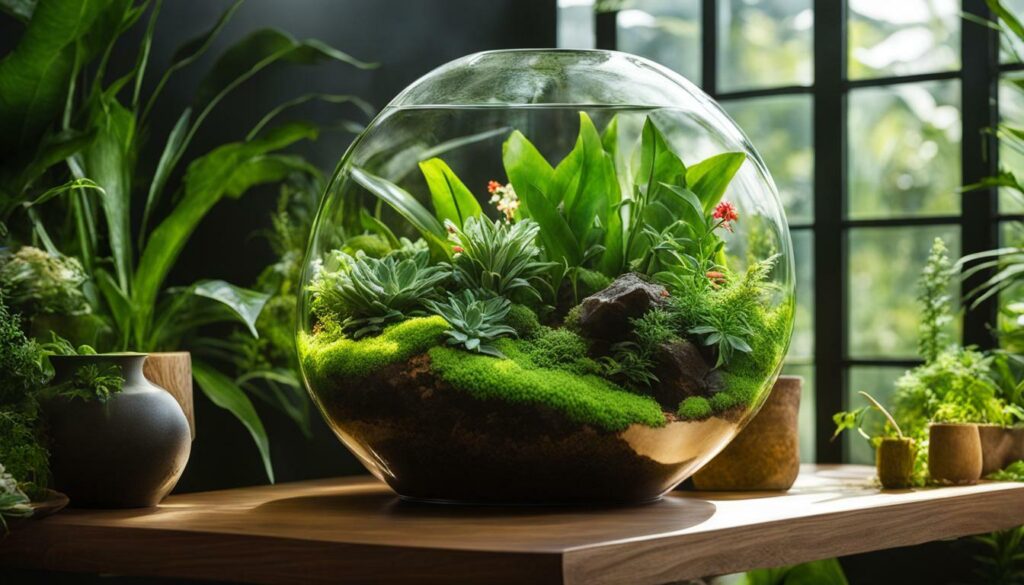
When it comes to selecting plants for your large terrarium, consider ferns, foliage plants, vines, epiphytes, and moss. These plants offer a range of textures, colors, and growth habits, allowing you to create a visually stunning and harmonious terrarium. Experiment with different combinations and arrangements to achieve the desired look and feel. Don’t forget to consider the lighting and humidity requirements of each plant to ensure their overall health and well-being in the terrarium.
Essential Ingredients for Building Large Terrariums
Building a large terrarium requires a few essential ingredients to create a suitable environment for your plants, including a well-chosen glass container, effective drainage layers, high-quality soil, and carefully selected hardscape materials. Let’s delve into each of these components to understand their importance:
- Glass Container: Selecting the right glass container is crucial for the success of your large terrarium. Opt for a container with a wide opening to allow easy access for planting and maintenance. Additionally, ensure that the glass is clear and free from any scratches or cracks, as this will affect the overall aesthetic appeal of your terrarium.
- Drainage Layers: Adequate drainage is essential to prevent water from accumulating and causing root rot. Add a layer of small stones or pebbles at the bottom of your terrarium to facilitate drainage. This layer will also help prevent the soil from becoming waterlogged.
- Soil: Choosing the right soil is crucial for the health and growth of your terrarium plants. Opt for a well-draining potting mix specifically formulated for indoor plants. Avoid using garden soil, as it can compact and retain excessive moisture, which is not suitable for terrariums.
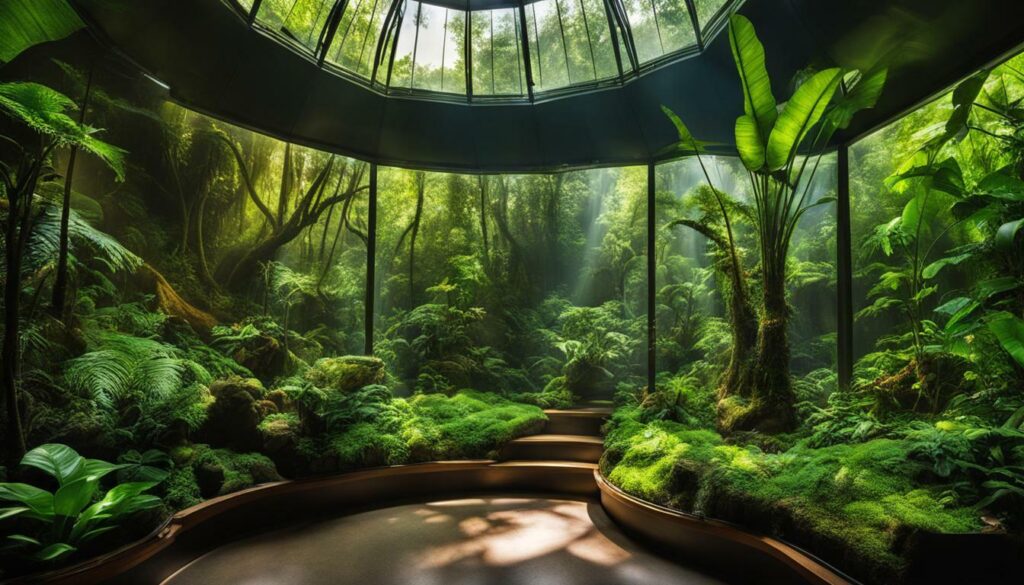
Hardscape Materials: Hardscape materials such as rocks, driftwood, or decorative elements play a vital role in creating visual interest and adding texture to your terrarium. These materials also serve as anchors for your plants, providing stability and support.
By carefully selecting and combining these essential ingredients, you can create a thriving and visually appealing large terrarium. Remember to consider the specific needs and preferences of your chosen terrarium plants when selecting these components. With a little bit of creativity and attention to detail, your large terrarium will become a captivating centerpiece in any space.
Proper Care and Maintenance of Large Terrariums
Caring for your large terrarium involves regular maintenance tasks such as watering, managing condensation levels, removing dead leaves and flowers, pruning plants, and refraining from fertilizing. These tasks are essential to ensure the health and longevity of your terrarium ecosystem.
Watering is a critical aspect of terrarium care. It’s important to strike a balance between providing enough moisture to sustain the plants and avoiding excessive water accumulation. Before watering, check the moisture level of the soil by inserting your finger about an inch deep. If it feels dry, it’s time to water. Use a spray bottle or a watering can with a narrow spout to target the soil directly, avoiding the plants’ foliage. Overwatering can lead to root rot and other issues.
Condensation is a natural occurrence in closed terrariums, but excessive moisture buildup can be detrimental to the plants. Monitor the condensation levels by periodically removing the lid or opening the vents for a short period to allow air circulation. This will help to prevent the growth of mold or bacteria. If condensation persists, reduce the frequency and duration of watering.
In order to maintain the visual appeal of your large terrarium, it’s important to remove dead leaves and flowers regularly. This will not only keep the terrarium looking tidy but also prevent the buildup of decaying organic matter, which can attract pests or cause fungal problems. Use a pair of small scissors or pruning shears to carefully snip off any dead or dying plant parts.
Proper pruning is essential for maintaining the shape and size of the plants in your terrarium. Trim back any overgrown foliage to prevent overcrowding and create a more balanced aesthetic. Be cautious not to remove more than one-third of the plant’s growth at a time, as this can cause stress and affect its overall health.
When it comes to fertilizing, it’s best to avoid it altogether. Terrariums are self-contained ecosystems, and the plants receive nutrients from the soil and decaying matter within the container. Adding additional fertilizer can disrupt this delicate balance and lead to overgrowth or nutrient imbalances. It’s best to rely on the natural processes within the terrarium to sustain the plants.
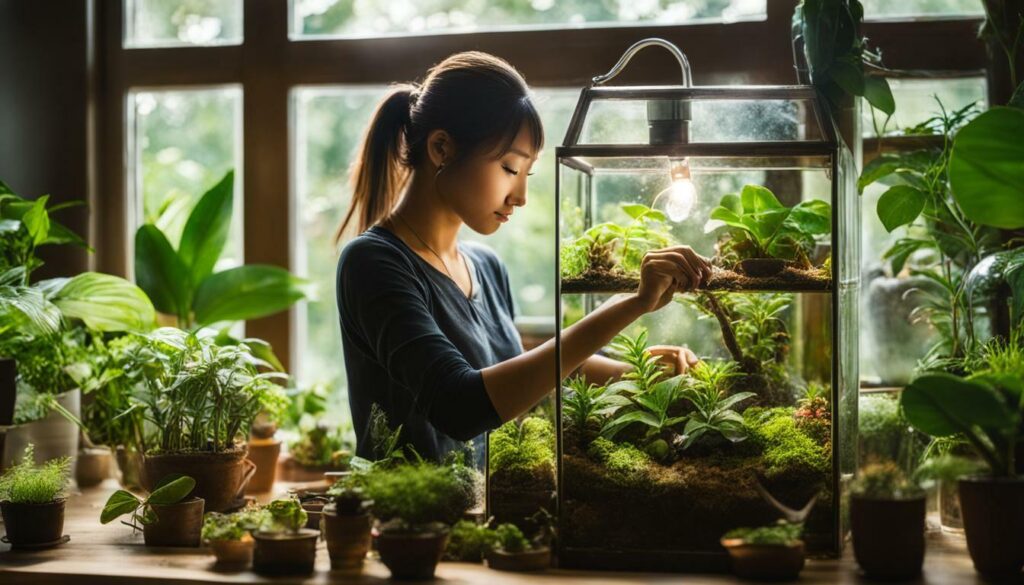
By following these care and maintenance guidelines, you can ensure that your large terrarium thrives and remains a beautiful addition to your home or office space. Remember to monitor watering and condensation levels, remove dead plant parts, prune when necessary, and avoid fertilizing. With proper care, your large terrarium will bring you joy and a touch of nature for years to come.
Pros and Cons of Closed and Open Terrariums
Both closed and open terrariums have their own unique advantages and considerations to keep in mind when deciding which type is best suited for your preferences and environment. Closed terrariums, also known as self-contained ecosystems, are sealed glass containers that create a humid environment ideal for tropical plants. The sealed nature of closed terrariums allows for recycling of water, creating a self-sustaining ecosystem. These terrariums require very little maintenance once established and are excellent for those who want a low-maintenance indoor garden. However, the lack of airflow in closed terrariums can lead to excess moisture and the growth of mold or bacteria if not properly managed.
On the other hand, open terrariums provide better airflow and are suitable for arid plant species that prefer lower moisture levels. These terrariums have an open or partially open top, allowing air to circulate and preventing excessive humidity buildup. Open terrariums are easier to maintain in terms of moisture control and are less prone to issues such as mold. However, they require more regular watering and monitoring to ensure the right level of moisture is maintained for the plants.
When deciding between closed and open terrariums, consider the type of plants you want to cultivate, the level of maintenance you are willing to commit to, and the environmental conditions of your space. Closed terrariums are well-suited for individuals who prefer a hands-off approach and have limited time for plant care. Open terrariums, on the other hand, are more suitable for those who enjoy more active involvement in plant care and are comfortable with regular watering and monitoring of moisture levels.
Whichever type of terrarium you choose, it’s important to select plants that are suitable for the specific environment you are creating. Certain plants thrive in the humid conditions of closed terrariums, while others prefer the drier conditions of open terrariums. Take into consideration the light requirements, growth habits, and overall care needs of the plants you choose to ensure their success in your terrarium.
Table: Pros and Cons of Closed and Open Terrariums
| Pros | Cons |
|---|---|
| Low maintenance once established | Potential issues with mold or bacteria if not properly managed |
| Creates a self-sustaining ecosystem | Less airflow compared to open terrariums |
| Excellent for tropical plant species | May require additional monitoring and watering |
| Aesthetically pleasing sealed environment | Can be challenging to adjust moisture levels |
| Better airflow and less prone to mold | Requires more regular watering |
| More suitable for arid plant species | Requires active involvement in plant care |
Remember, whether you choose a closed or open terrarium, the success of your mini-ecosystem relies on careful plant selection, proper maintenance, and the right balance of light and moisture. With a little knowledge and attention, you can create a stunning and thriving terrarium that brings a touch of nature into your home or office.
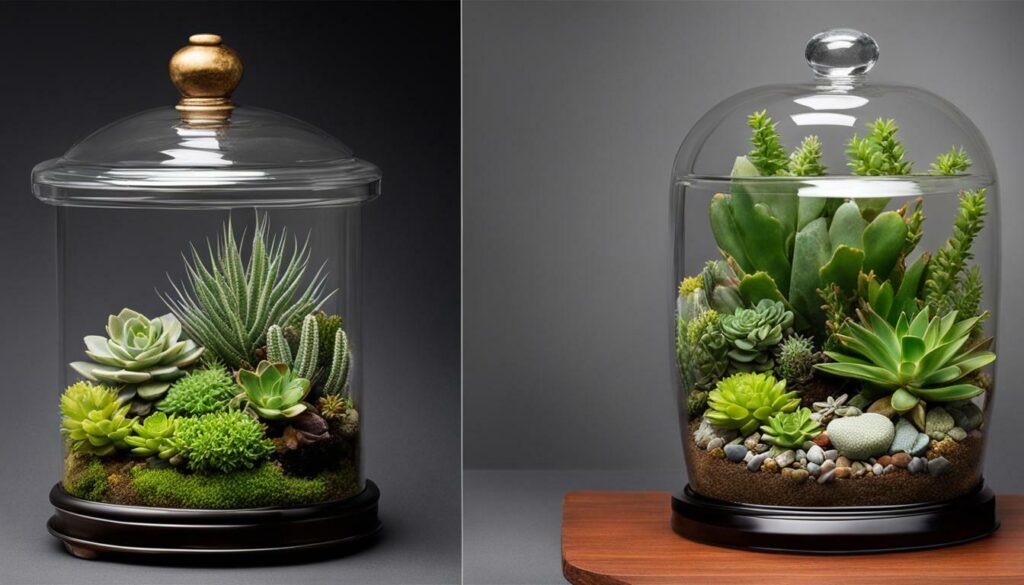
Adding personal touches to your large terrarium can make it even more visually appealing and unique. Consider enhancing it with accessories that reflect your style, such as colored pebbles, fairy garden supplies, and a carefully chosen glass container.
Colored pebbles are a fantastic way to add a pop of color to your terrarium. They come in various shades, from vibrant blues and greens to earthy tones like amber and terracotta. You can use them to create beautiful patterns or simply scatter them around your plants for a touch of whimsy. The pebbles not only add visual interest but also help with drainage and moisture regulation.
Fairy garden supplies, such as miniature figurines, tiny fences, and whimsical mushrooms, can bring a magical element to your terrarium. These accessories can create a sense of enchantment and wonder, transforming your terrarium into a tiny world of its own. Let your imagination run wild and create a scene that tells a story.
The glass container you choose for your terrarium is not just a vessel but also an opportunity to showcase your personal style. Opt for a container that complements the overall aesthetic you want to achieve. From classic geometric shapes to elegant orbs, there are countless options available. Consider the size, shape, and transparency of the container to create a harmonious and visually pleasing composition.
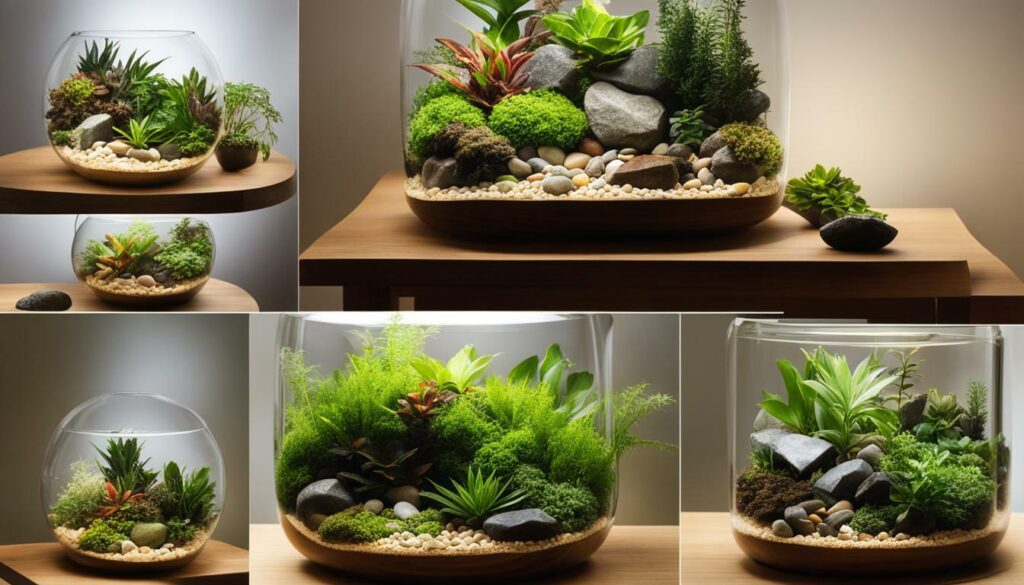
| Accessories | Description |
|---|---|
| Colored Pebbles | Add a pop of color and improve drainage and moisture regulation. |
| Fairy Garden Supplies | Bring a touch of magic with miniature figurines and whimsical decorations. |
| Glass Container | Showcase your personal style with a carefully chosen vessel. |
“Adding personal touches to your large terrarium can make it even more visually appealing and unique.”
Remember, your terrarium is a reflection of your creativity and style. Experiment with different accessories and arrangements until you find a combination that speaks to you. Let your terrarium become a miniature oasis that brings joy and tranquility to your space.
Terrariums as Home Decor and DIY Projects
Large terrariums not only bring the beauty of nature into your home but also serve as stunning decorative accents. Additionally, creating your own large terrarium can be a rewarding and engaging DIY project. Whether you have a green thumb or are new to gardening, terrariums offer a unique and customizable way to incorporate plants into your home decor.
With their ability to create miniature landscapes, terrariums provide a captivating focal point in any room. By carefully selecting plants, rocks, and other decorative elements, you can design a terrarium that complements your existing interior aesthetics. Choose plants with different textures, heights, and colors to create an eye-catching display. The versatility of large terrariums allows you to experiment with various styles, from lush tropical environments to desert-inspired arrangements.
When it comes to DIY projects, building a large terrarium offers endless possibilities. Start by gathering the necessary materials, including a glass container, drainage layers, suitable soil, and hardscape materials such as rocks or driftwood. Research different plant species and their specific care requirements to ensure a thriving terrarium. Get creative with the arrangement of plants and decorative elements, adding your personal touch to the design. Consider incorporating accessories like colored pebbles, fairy garden supplies, or miniature figurines to enhance the visual appeal of your terrarium.
Creating and maintaining a terrarium can be a fulfilling and relaxing hobby. It allows you to cultivate and care for a mini ecosystem, promoting mindfulness and connection with nature. Terrariums also make great gifts for friends and loved ones, as they are unique and personalized creations that can brighten up any space. So why not embark on a DIY terrarium project and bring a touch of greenery and tranquility into your home?
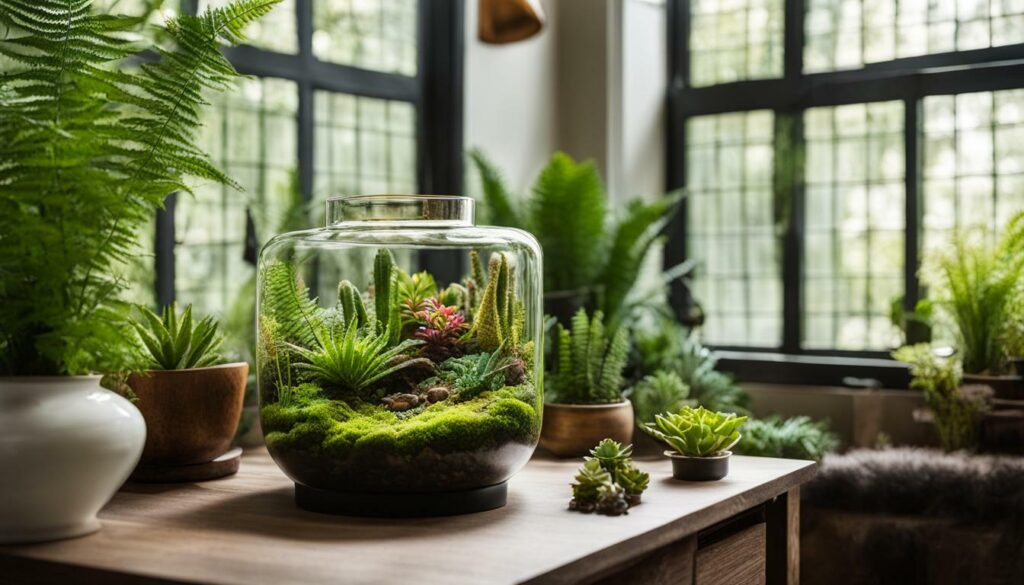
| Pros of Large Terrariums | Cons of Large Terrariums |
|---|---|
| Brings nature indoors | Requires regular maintenance |
| Serves as a decorative accent | Can be susceptible to pests or diseases |
| Customizable and versatile | Needs careful plant selection |
| Engaging DIY project | Requires proper light and humidity levels |
Key Takeaways:
- Large terrariums add a touch of natural beauty to your home decor.
- Creating your own large terrarium can be a rewarding DIY project.
- Experiment with different plants, rocks, and accessories to personalize your terrarium.
- Terrariums provide a calming and mindful gardening experience.
- Consider the pros and cons of large terrariums before getting started.
Conclusion
Large terrariums offer a delightful way to create your own indoor ecosystem, filled with lush greenery and a touch of natural elegance. These self-sustaining wonders are easy to create and maintain, making them a perfect addition to any space.
When selecting terrarium plants, it’s important to consider the type of terrarium you have. Closed terrariums are suitable for tropical plants that thrive in high humidity, while open terrariums are better suited for arid species that prefer low moisture and good airflow.
Popular plant options for terrariums include ferns, foliage plants, vines, epiphytes, and moss. It’s essential to choose plants that are well-suited for the environment you are creating. Opting for miniature varieties and slower-growing plants can make maintenance easier in the long run.
To create a large terrarium, you’ll need a suitable glass container, proper drainage layers, suitable soil, and hardscape materials such as rocks or driftwood to add visual interest. Proper care includes consistent watering, managing condensation levels, and regular maintenance tasks such as deadheading and pruning. It’s important to avoid fertilizing terrarium plants, as this can lead to overgrowth and nutrient imbalances.
There are pros and cons to both closed and open terrariums. Closed terrariums require less maintenance but can be prone to bacterial growth if not properly managed. Open terrariums, on the other hand, offer better air circulation but require careful attention to moisture levels. Consider these factors when deciding which type of terrarium is best for you.
Customizing your large terrarium with personal touches can enhance its visual appeal. You can add colored pebbles, fairy garden supplies, or experiment with different types of glass containers to create a unique and eye-catching display.
Terrariums not only add a touch of greenery and nature to your home but also serve as wonderful gifts and engaging DIY projects. Their ease of creation and maintenance, coupled with their beauty, make them a popular choice for both plant enthusiasts and beginners alike.
Overall, large terrariums provide a simple yet captivating way to bring the beauty of nature inside. With a little creativity and care, you can create a stunning indoor oasis that will brighten up any space.
How do Air Plant Terrariums Differ from Large Terrariums?
Air plant terrariums today are unique because they feature air plants, which don’t require soil to grow. This allows for more creative and diverse design options compared to traditional large terrariums. Additionally, air plant terrariums can be smaller in size and easier to care for, making them a popular choice for indoor gardening enthusiasts.
FAQ
What are the different types of terrarium plants?
There are closed terrarium plants, which thrive in hot and humid conditions, and open terrarium plants, which prefer low moisture and humidity environments with good airflow.
What are some popular terrarium plant options?
Popular terrarium plant options include ferns, foliage plants, vines, epiphytes, and moss.
What factors should I consider when selecting plants for my large terrarium?
It’s important to choose plants that are suitable for the environment you are creating. Miniature varieties and slower-growing plants are recommended for easier maintenance.
What components do I need to build a large terrarium?
To build a large terrarium, you’ll need a suitable glass container, drainage layers, soil, and hardscape materials like rocks or driftwood.
How do I care for and maintain my large terrarium?
Proper care for your large terrarium includes regular watering, keeping condensation in check, deadheading and pruning plants, and avoiding fertilization.
What are the pros and cons of closed and open terrariums?
Closed terrariums require less maintenance but can have issues with bacteria if not properly managed, while open terrariums have better air circulation but require more attention to moisture levels.
How can I enhance my large terrarium with personal touches?
You can customize your large terrarium with additional accessories like colored pebbles and fairy garden supplies, and choose different types of glass containers.
Are terrariums suitable for home decor and DIY projects?
Yes, terrariums make beautiful home decor elements and can be engaging DIY projects.

